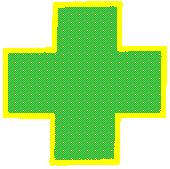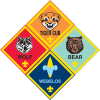 In emergencies, someone has to be ready to help. After you earn the Readyman activity badge, you’ll know how to react quickly when someone is ill or injured.
In emergencies, someone has to be ready to help. After you earn the Readyman activity badge, you’ll know how to react quickly when someone is ill or injured.
You’ll be ready to call for emergency help. When you learn first aid, you can care for a sick or injured person until help arrives.
You’ll also find out how to prevent accidents and how to be safe when swimming and biking. You’ll help your family be safe at home and when traveling by car.
Learning the skills that prevent accidents and help in emergencies will make you a Readyman.
Requirements
Do all of these:
1. With your parent, guardian, or Webelos den leader, complete the Courage Character Connection.
a. Know: Define the importance of each courage step: Be strong; Be calm; Be clear; Be careful. Explain how memorizing the courage steps helps you to be ready.
b. Commit: Explain why it is hard to follow the courage steps in an emergency. Tell when you can use the courage steps in other situations (such as standing up to a bully, avoiding fights, being fair, not stealing or cheating when tempted, etc.)
c. Practice: Act out one of the requirements using these courage steps: Be strong; Be calm; Be clear; Be careful.
2. Explain what first aid is. Tell what you should do after an accident.
3. Explain how you can get help quickly if there is an emergency in your home. Make a “help list” of people or agencies that can help you if you need it. Post it near a phone or in another place with easy access.
4. Demonstrate the Heimlich maneuver and tell when it is used.
5. Show what to do for these “hurry cases”:
• Serious bleeding
• Stopped breathing
• Internal poisoning
• Heart attack
6. Show how to treat shock.
7. Show first aid for the following:
• Cuts and scratches
• Burns and scalds
• Choking
• Blisters on the hand and foot
• Tick bites
• Bites and stings of insects other than ticks
• Poisonous snakebite
• Nosebleed
• Frostbite
• Sunburn
8. Tell what steps must be taken for a safe swim with your Webelos den, pack, family, or other group. Explain the reasons for the buddy system.
And do two of these:
9. Explain six safety rules you should follow when “driving” a bicycle.
10. Explain the importance of wearing safety equipment when participating in sports activities (skating, skateboarding, etc.)
11. Make a home fire escape plan for your family.
12. Explain how to use each item in a first aid kit.
13. Tell where accidents are most likely to happen inside and around your home.
14. Explain six safety rules you should remember when riding in a car.
15. Attend a first aid demonstration at a Boy Scout troop meeting, a Red Cross center, or other community event or place.






